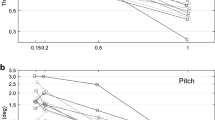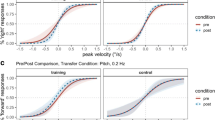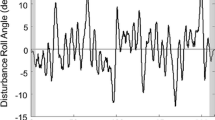Abstract
A theme in sensory perception is that exposure to a stimulus causes perception of subsequent stimuli to be shifted in the opposite direction. Such phenomenon is known as aftereffect and has been extensively described in the visual system as well as recently described for the vestibular system during translation. It is known from aviation studies that after a maneuver in roll, pilots can experience a false perception of roll in the opposite direction. The magnitude and duration of this effect as well as the potential influence of the gravity vector have not previously been defined. In the current paper this roll aftereffect (RAE) is examined in response to whole-body roll about an earth-horizontal axis in eight healthy human subjects. The peak velocity of a 0.5-s-duration roll was varied based on previous responses to find the point where subjects perceived no motion. Without a preceding stimulus, the starting position (upright, 9° left, or 9° right) did not influence roll perception. The RAE was measured in a completely dark room using an adapting (first interval) stimulus consisting of 9° of roll over 1.5 s (peak velocity, 12°/s), delivered 0.5, 3, or 6 s prior to test (second interval) stimulus. A significant RAE was seen in all subjects. Half a second after the adapting stimulus, a test stimulus had to be on average 1.5 ± 0.4°/s in the opposite direction to be perceived as stationary. When the subject remained upright after the adapting stimulus, the RAE diminished with time, although it remained significantly larger at 3 and 6 s when the subject remained tilted after the adapting stimulus. These data demonstrate that roll perception can be influenced by small preceding stimuli and tilt causes a persistence of the RAE.





Similar content being viewed by others
References
Addams R (1834) An account of a peculiar optical phenomenon seen after having looked at a moving body etc. Mag J Sci, 3rd series 5:373–374
Anstis S, Verstraten FA, Mather G (1998) The motion aftereffect. Trends Cogn Sci 2:111–117
Barlow HB (1990) A theory about the functional role and synaptic mechanism of visual aftereffects. In: Blakemore C (ed) Vision: coding and efficiency. Cambridge University Press, Cambridge, pp 363–375
Benson AJ, Spencer MB, Stott JR (1986) Thresholds for the detection of the direction of whole-body, linear movement in the horizontal plane. Aviat Space Environ Med 57:1088–1096
Bertolini G, Bockisch CJ, Straumann D, Zee DS, Ramat S (2008) Do humans show velocity-storage in the vertical rVOR? Prog Brain Res 171:207–210. doi:10.1016/S0079-6123(08)00628-6
Bertolini G, Ramat S, Laurens J, Bockisch CJ, Marti S, Straumann D, Palla A (2011) Velocity storage contribution to vestibular self-motion perception in healthy human subjects. J Neurophysiol 105:209–223. doi:10.1152/jn.00154.2010
Bestelmeyer PE, Rouger J, DeBruine LM, Belin P (2010) Auditory adaptation in vocal affect perception. Cognition 117:217–223. doi:10.1016/j.cognition.2010.08.008
Carriot J, Barraud PA, Nougier V, Cian C (2006) Difference in the perception of the horizon during true and simulated tilt in the absence of semicircular canal cues. Exp Brain Res 174:158–166
Clark B, Graybiel A (1968) Influence of contact cues on the perception of the oculogravic illusion. Acta Otolaryngol 65:373–380
Cohen H, Cohen B, Raphan T, Waespe W (1992) Habituation and adaptation of the vestibuloocular reflex: a model of differential control by the vestibulocerebellum. Exp Brain Res 90:526–538
Crane BT (2012) Fore-aft translation aftereffects. Exp Brain Res 219:477–487
Crane BT, Demer JL (2000) Effect of adaptation to telescopic spectacles on the initial human horizontal vestibuloocular reflex. J Neurophysiol 83:38–49
Dai M, Klein A, Cohen B, Raphan T (1999) Model-based study of the human cupular time constant. J Vestib Res 9:293–301
Ercoline WR, Devilbiss CA, Yauch DW, Brown DL (2000) Post-roll effects on attitude perception: “the Gillingham illusion”. Aviat Space Environ Med 71:489–495
Fetsch CR, Turner AH, Deangelis GC, Angelaki DE (2009) Dynamic re-weighting of visual and vestibular cues during self-motion perception. J Neurosci 29:15601–15612
Gillingham KK (1992) The spatial disorientation problem in the United States Air Force. J Vestib Res 2:297–306
Grabherr L, Nicoucar K, Mast FW, Merfeld DM (2008) Vestibular thresholds for yaw rotation about an earth-vertical axis as a function of frequency. Exp Brain Res 186:677–681
Graybiel A, Patterson JL Jr (1955) Thresholds of stimulation of the otolith organs as indicated by the oculogravic illusion. J Appl Physiol 7:666–670
Graybiel A, Johnson WH, Money KE, Malcolm RE, Jennings GL (1979) Oculogravic illusion in response to straight-ahead acceleration of CF-104 aircraft. Aviat Space Environ Med 50:382–386
Groen EL, Jenkin HL, Howard IP (2002) Perception of self-tilt in a true and illusory vertical plane. Perception 31:1477–1490
Guedry FE Jr (1974) Psychophysics of vestibular sensation. In: Kornhuber HH (ed) Handbook of sensory physiology. Springer, New York, pp 3–154
Heinle TE, Ercoline WR (2002) Spatial disorientation: Causes consequences, and countermeasures for the USAF. Paper presented at the RTO HFM symposium on spatial disorientation in military vehicles: causes, consequences, and cures. La Coruña, Spain, 15–17 April 2002
Hess BJ, Angelaki DE (1997) Inertial vestibular coding of motion: concepts and evidence. Curr Opin Neurobiol 7:860–866
Howard IP, Hu G (2001) Visually induced reorientation illusions. Perception 30:583–600
Janssen M, Lauvenberg M, van der Ven W, Bloebaum T, Kingma H (2011) Perception threshold for tilt. Otol Neurotol 32:818–825. doi:10.1097/MAO.0b013e31821c6c7b
Kanai R, Verstraten FA (2005) Perceptual manifestations of fast neural plasticity: motion priming, rapid motion aftereffect and perceptual sensitization. Vis Res 45:3109–3116. doi:10.1016/j.visres.2005.05.014
Lyons TJ, Ercoline WR, Freeman JE, Gillingham KK (1994) Classification problems of US Air Force spatial disorientation accidents, 1989–1991. Aviat Space Environ Med 65:147–152
MacNeilage PR, Banks MS, DeAngelis GC, Angelaki DE (2010) Vestibular heading discrimination and sensitivity to linear acceleration in head and world coordinates. J Neurosci 30:9084–9094. doi:10.1523/JNEUROSCI.1304-10.2010
Mann CW (1950) Studies in space perception. Naval School of Aviation Medicine, Pensacola
Mann CW, Dauterive HJ Jr (1949) The perception of the vertical. I. The modification of non-labyrinthine cues. J Exp Psychol 39:700–707
Merfeld DM, Gong W, Morrissey J, Saginaw M, Haburcakova C, Lewis RF (2006) Acclimation to chronic constant-rate peripheral stimulation provided by a vestibular prosthesis. IEEE Trans Biomed Eng 53:2362–2372. doi:10.1109/TBME.2006.883645
Miles FA, Eighmy BB (1980) Long-term adaptive changes in primate vestibuloocular reflex. I. Behavioral observations. J Neurophysiol 43:1406–1425
Nooij SA, Groen EL (2011) Rolling into spatial disorientation: simulator demonstration of the post-roll (Gillingham) illusion. Aviat Space Environ Med 82:505–512
Paige GD, Tomko DL (1991) Eye movement responses to linear head motion in the squirrel monkey. I. Basic characteristics. J Neurophysiol 65:1170–1182
Raphan T, Matsuo V, Cohen B (1979) Velocity storage in the vestibulo-ocular reflex arc (VOR). Exp Brain Res 35:229–248
Reinhardt-Rutland AH (1998) Increasing-loudness aftereffect following decreasing-intensity adaptation: spectral dependence in interotic and monotic testing. Perception 27:473–482
Roditi RE, Crane BT (2012a) Directional asymmetries and age effects in human self-motion perception. J Assoc Res Otolaryngol 13:381–401
Roditi RE, Crane BT (2012b) Suprathreshold asymmetries in human motion perception. Exp Brain Res 219:369–379
Seidman SH, Telford L, Paige GD (1998) Tilt perception during dynamic linear acceleration. Exp Brain Res 119:307–314
Seizova-Cajic T, Smith JL, Taylor JL, Gandevia SC (2007) Proprioceptive movement illusions due to prolonged stimulation: reversals and aftereffects. PLoS One 2:e1037. doi:10.1371/journal.pone.0001037
Thompson P, Burr D (2009) Visual aftereffects. Curr Biol 19:R11–R14. doi:10.1016/j.cub.2008.10.014
Tweed D, Fetter M, Sievering D, Misslisch H, Koenig E (1994) Rotational kinematics of the human vestibuloocular reflex. II. Velocity steps. J Neurophysiol 72:2480–2489
Ullman S, Schechtman G (1982) Adaptation and gain normalization. Proc R Soc Lond Ser B 216:299–313
Wichmann FA, Hill NJ (2001a) The psychometric function: I. Fitting, sampling, and goodness of fit. Percept Psychophys 63:1293–1313
Wichmann FA, Hill NJ (2001b) The psychometric function: II. Bootstrap-based confidence intervals and sampling. Percept Psychophys 63:1314–1329
Acknowledgments
This work was funded by a grant from the National Institute on Deafness and Other Communication Disorders K23 DC011298. Additional support was provided by a clinician-scientist grant from the Triological Society. Technical support was provided by Shawn Olmstead-Leahey. Thanks to my former mentor, Dr. Joseph L. Demer, for reviewing a pre-publication version of this manuscript.
Author information
Authors and Affiliations
Corresponding author
Rights and permissions
About this article
Cite this article
Crane, B.T. Roll aftereffects: influence of tilt and inter-stimulus interval. Exp Brain Res 223, 89–98 (2012). https://doi.org/10.1007/s00221-012-3243-0
Received:
Accepted:
Published:
Issue Date:
DOI: https://doi.org/10.1007/s00221-012-3243-0




